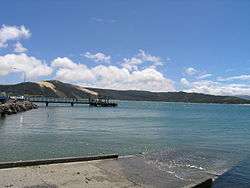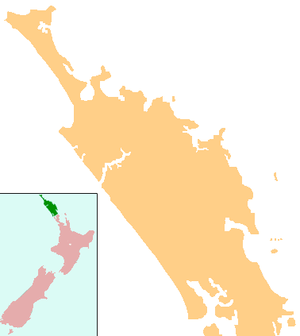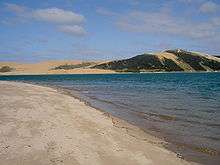Opononi
Opononi and Omapere are dual settlements on the south shore of the Hokianga harbour in Northland Region, New Zealand.[1] State Highway 12 runs through Opononi and Omapere.
Opononi & Omapere | |
|---|---|
 Opononi wharf | |
 Opononi & Omapere | |
| Coordinates: 35°30′45″S 173°23′25″E | |
| Country | New Zealand |
| Region | Northland Region |
| District | Far North District |
| Population (2018) | |
| • Total | 525 |

The combined population of Opononi and Omapere was about 525 in the 2018 Census.[2]
The New Zealand Ministry for Culture and Heritage gives translations of "place of [a] crooked fishing post" for Ōpononi and "place of cutty grass" for Ōmāpere.[3]
Demographics
| Year | Pop. | ±% p.a. |
|---|---|---|
| 2006 | 1,119 | — |
| 2013 | 1,035 | −1.11% |
| 2018 | 1,215 | +3.26% |
| Source: [4] | ||
The statistical area of Waipoua Forest, which is much larger than the Opononi-Omapere settlement area at 278 square kilometres, stretches from the Hokianga south coast to the boundary with Kaipara District. It had a population of 1,215 at the 2018 New Zealand census, an increase of 180 people (17.4%) since the 2013 census, and an increase of 96 people (8.6%) since the 2006 census. There were 504 households. There were 579 males and 633 females, giving a sex ratio of 0.91 males per female. Of the total population, 222 people (18.3%) were aged up to 15 years, 162 (13.3%) were 15 to 29, 516 (42.5%) were 30 to 64, and 318 (26.2%) were 65 or older. Figures may not add up to the total due to rounding.
Ethnicities were 58.8% European/Pākehā, 57.3% Māori, 3.7% Pacific peoples, 2.0% Asian, and 0.7% other ethnicities. People may identify with more than one ethnicity.
The percentage of people born overseas was 9.1, compared with 27.1% nationally.
Although some people objected to giving their religion, 42.5% had no religion, 44.4% were Christian, and 4.7% had other religions.
Of those at least 15 years old, 123 (12.4%) people had a bachelor or higher degree, and 219 (22.1%) people had no formal qualifications. The median income was $18,800. The employment status of those at least 15 was that 270 (27.2%) people were employed full-time, 195 (19.6%) were part-time, and 72 (7.3%) were unemployed.[4]
History
European settlement
The first European settler in the Omapere area was John Martin, who arrived in the Hokianga Harbour in 1827. In 1832 Martin purchased land on the flat area, along the beach at Omapere. In 1838 Martin extended his land purchase to the Hokianga Harbour's South Head, where he established a signal station to guide ships crossing the challenging harbour entrance. The signal station remained in operation until 1951.
In 1869, a bush licence was granted to Charles Bryers at Omapere. In the mid 1870s, a liquor licence was then given to the establishment called the 'Heads'. This later became the 'Travellers Rest'. By 1876 the farm of John Martin had become the township of Pakia. It was home to a hotel, two stores, several houses and a school house. The name Omapere began to be used more frequently and became Omapere by residents agreement in 1874.
In 1855, John Webster, who had arrived in New Zealand in 1841, bought 700 acres of rough land at Opononi and established a homestead and pastoral farm which he developed into a showplace, entertaining vice-royalty several times. He also built a wharf, gum-store and a trading store. In 1894, Webster put the house and farm on the market. The store and gum store were taken over by Alfred Sprye Andrewes who later converted the gum store into a two storey hotel.
20th century
The Opononi Post and Telephone was opened in 1892 and operated until 1989. The road between Opononi and Omapere was developed in the mid 1930s leading to ribbon development. In 1959, a fire destroyed the Opononi Hotel and Opononi Store.
Opononi became famous throughout New Zealand in the summer of 1955 and 1956 due to the exploits of a dolphin called Opo.[1]
Marae
The area has three marae affiliated with the Ngāpuhi hapū of Ngāti Korokoro, Ngāti Whārara and Te Poukā:[5]
- Pākanae Marae and Maraeroa meeting house
- Kōkōhuia or Ōmāpere Marae and Te Whakarongotai meeting house (also affiliated with Ngāti Te Pou)
- Waiwhatawhata or Aotea Marae and Te Kaiwaha meeting house.[6]
Education
The first school was the Pakia Native School which opened in 1874 under the Native School Act. In 1912 the school was renamed Omapere. Opononi did not have a school of its own and children either went to Pakia/Omapere School, or after it opened in 1909, to Pakanae School. In 1974, the newly built Opononi Area School replaced both.
Opononi Area School is a coeducational composite (years 1-15) school with a roll of 137 students.[7][8]
Notes
- "Hokianga district". Te Ara: The Encyclopedia of New Zealand.
- "Meshblock Electoral Populations 2020 for proposed boundaries data". Statistics New Zealand. April 2020. Meshblocks 0025800-0026100 and 4007509-4007513. Meshblock 0026001 had no displayed data due to very low population.
- "1000 Māori place names". New Zealand Ministry for Culture and Heritage. 6 August 2019.
- "Statistical area 1 dataset for 2018 Census". Statistics New Zealand. March 2020. Waipoua Forest (102900). 2018 Census place summary: Waipoua Forest
- "Te Kāhui Māngai directory". tkm.govt.nz. Te Puni Kōkiri.
- "Māori Maps". maorimaps.com. Te Potiki National Trust.
- "New Zealand Schools Directory". New Zealand Ministry of Education. Retrieved 26 April 2020.
- Education Counts: Opononi Area School
External links
| Wikimedia Commons has media related to Opononi. |

- Welcome to Opononi